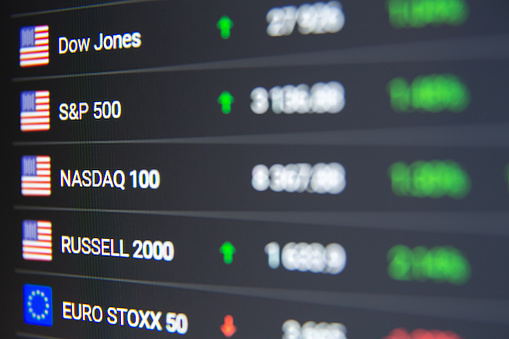The daily news is incomplete without a mention of the stock market and, more specifically, the Dow Jones Industrial Average (DJIA). You might’ve heard about points of the Dow falling or rising and being unsure of what that meant. This guide will introduce you to the Dow, how it works, and its history. We’ll also touch on some Dow Jones industrial companies that have made it what it is today. Let’s get started.
Read Dow Now: The Dow Jones Index – Market Live Overview.

What Is the Dow Jones Industrial Average?
The Dow Jones Industrial Average (DJIA) is a stock market index that aims to show how 30 large, publicly owned companies perform. It is often used as a barometer for the overall performance of the American stock market and economy.
The Dow is calculated by taking the Dow Jones stocks prices of the 30 companies and then finding the average. It is a “price-weighted” index, which means that stocks with a higher price have more impact on the index than those with a lower price.
Dow Divisor and Index Calculation
Created to address the simple average issue, the dow divisor is a predetermined constant used to determine the effect of a one-point move of 30-stocks. To keep the value of the Dow consistent, there have been times when the divisor needed to be changed. As of 2022, the Dow Divisor is 0.15172752595384.4.
Read DJI Quote: Everything You Need to Know.
The calculation is not a weighted arithmetic average and does not represent the component companies’ market capitalization. Instead, the sum of the price of one share of stock for all the components is divided by the divisor. Therefore, in any component stocks, a one-point move will shift the index by equal points.
DJIA Price = SUM (Component stock prices) / Dow Divisor

Important Functions Of Dow
Several important functions are served by Dow Jones Industrial Average (DJIA) in today’s marketplace:
Read What is the Dow Jones and why is it Important?
1. Comparison With Early Markets
Dow is a reminder and comparison of today’s market against early markets with its long history. This is helpful in trend analysis which is crucial for forecasting future market trends. The longevity of Dow provides this purpose better than any other indices.
2. Broad Overview of Economy
While DJIA tracks only 30 large US companies, these include all industries (except utilities and transportation) – giving a broad overview of the economy. As the stock market is a leading indicator, the direction of the Dow’s trend could be interpreted as representing the direction of the economy’s trend in the next year.
3. Unwarranted Media Attention
With its unmistakable and perhaps unwarranted amount of attention from the media, Dow is used as a proxy for the state of the economy in reporting. Despite not being fully representative of global, technology-driven market data, its psychological connection with the state of the economy is great.
The DJIA As A Dollar Value
With the Dow Jones Industrial Average (DJIA), you can think of it as a dollar value. To arrive at this number, you take the stock price of each company in the index and multiply it by the number of shares outstanding. Then, you add up all those figures to create the DJIA.
Read Dow Futures Today – What You Need to Know.
Let’s say that one company in the DJIA has a stock price increase of $5. To determine how this impacts the index, you need to divide that $5 by the current divisor. For example, if the current divisor is 0.147, you would take five and divide it by 0.147. This would give you a figure of 34.01.
In other words, if the DJIA is up 100 points on a given day, that company’s stock price increase of $5 was responsible for 34.42 points of the movement. This is how you can determine the impact of any particular stock on the index.
The Dow Jones And The Broader Market
Along with the Nasdaq Composite and Standard & Poor’s 500, the Dow Jones Industrial Average (DJIA) is one of the three major stock market indexes in the United States. The DJIA is perhaps the most widely publicized and discussed of these indexes and is also easy to calculate and understand.
Read After Hours Dow – Everything You Need to Know.
Being one of the three major stock market indexes in the United States, the DJIA provides a broad signal of how markets perform during the day. While it may not be as accurate or comprehensive an indicator as the other two indexes, its simplicity makes it a popular choice for those looking to get a quick market snapshot.

Limitations Of The DJIA
It’s important to understand the limitations of the Dow Jones Industrial Average before making any decisions based on it. Critics argue that it doesn’t accurately represent the state of the economy as it only consists of 30 large-cap companies. The number of Dow Jones companies is too small, and it neglects companies of different sizes.
S&P 500 better represents the economy as it includes significantly more companies, 500 versus 30. Furthermore, critics believe that factoring only the price of a stock in the calculation does not accurately reflect a company. A higher stock price with a smaller market cap would have more weight than a company with a smaller stock price but a larger market cap.
Read SPDR Dow Jones Industrial Average ETF | DIA Stock.
Contrasting the market capitalization weighting of the S&P 500, the Dow is a price-weighted index. This means that stocks in the index with higher share prices have greater influence regardless if they are smaller companies overall in terms of market value. Stock splits can impact the index, whereas they would not qualify for a market cap-weighted index.
Conclusion
To sum up, the Dow Jones Industrial Average is a stock index composed of 30 blue-chip industrial and financial companies in the United States. The index is price-weighted, meaning that changes in share prices are reflected proportionately in the index. The Dow is often a barometer for the overall stock market and economy. While the Dow’s scope is more limited than other indices like the S&P 500, it is still a popular and influential index.
We hope this guide has helped you better understand DJIA. If you’ve any questions, please feel free to reach out in the comments below.


